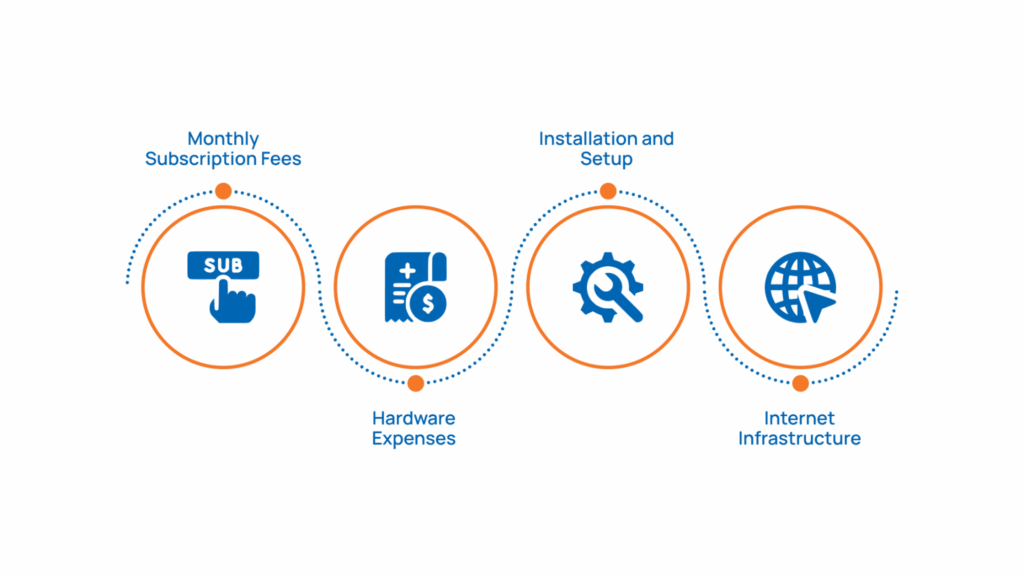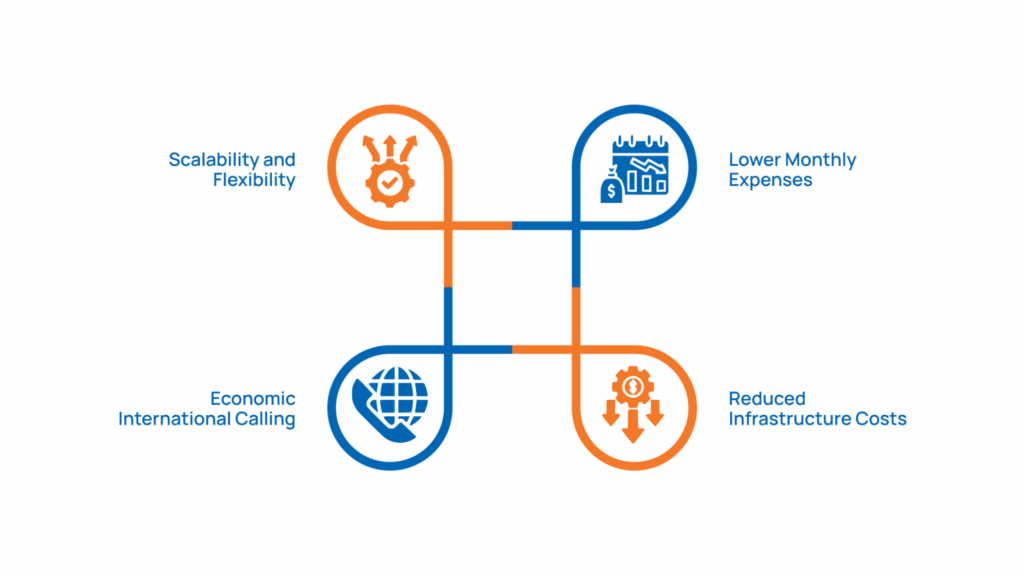Key Takeaways
|
Essential Pricing Factors to Know Before Choosing a VoIP Plan
 The cost of a VoIP system depends on several practical factors. Here is the list of factors that influence overall pricing.
The cost of a VoIP system depends on several practical factors. Here is the list of factors that influence overall pricing.
-
Number of Users
-
Features & Add-ons
-
Hardware Requirements
-
Call Volume & Geography
-
Support & SLA Levels
VoIP Costs in 2025: What Your Business Is Paying For
 Understanding what contributes to VoIP pricing is crucial for accurate budgeting. Below are the core components that make up the total cost of a VoIP system in 2025.
Understanding what contributes to VoIP pricing is crucial for accurate budgeting. Below are the core components that make up the total cost of a VoIP system in 2025.
-
Monthly Subscription Fees
-
Hardware Expenses
-
Installation and Setup
-
Internet Infrastructure
Hidden and Additional VoIP Costs to Consider in VoIP
While VoIP systems are generally cost-effective, businesses should be aware of additional charges beyond the base subscription before committing.-
Add-On Features
-
International Calling Charges
-
Number Porting Fees
-
Maintenance and Support
Cost Benefits of Switching to a VoIP Phone System
 Switching to a VoIP phone system in 2025 offers businesses significant cost benefits compared to traditional telephony. Here's an overview of the primary cost-saving advantages:
Switching to a VoIP phone system in 2025 offers businesses significant cost benefits compared to traditional telephony. Here's an overview of the primary cost-saving advantages:
-
Lower Monthly Expenses
-
Reduced Infrastructure Costs
-
Economic International Calling
-
Scalability and Flexibility
VoIP vs. Traditional Phone Systems: Cost Analysis
To understand the value of VoIP, it’s essential to compare its costs directly with those of traditional landline systems. Below is a detailed comparison to help you evaluate which option offers better long-term value for your business.-
Monthly Service Fees
-
Setup and Installation Costs
-
Maintenance and Support
-
Call Charges
| Cost Comparison Table | ||
|---|---|---|
| Aspect | VoIP | Traditional Landline |
| Monthly Fees | $10–$30 per user | $50–$80 per line |
| Setup Costs | Minimal to $160 per device | $150–$1,200 depending on setup |
| Maintenance | Often included | Varies; additional costs |
| Call Charges | Included or low rates | Per-minute charges apply |
Short-Term vs. Long-Term VoIP Contracts: What It Means for Your Costs
When selecting a VoIP provider, the length of your contract can significantly influence both immediate and long-term costs. Understanding these implications is crucial for making informed decisions that align with your business needs. Short-term (Month-to-Month) agreements offer flexibility, allowing businesses to adapt quickly to changing needs. However, they often come with higher monthly rates. Long-Term Commitments (12 Months or More) providers may offer discounted rates, waived setup fees, or additional features for businesses willing to commit to longer terms. This can lead to significant cost savings over time. Here’s why committing long-term can be a strategic advantage for your business.- Providers often offer discounts or waive setup fees for clients who commit to more extended contracts. This can result in immediate savings, especially for businesses requiring extensive installations.
- Long-term agreements lock in rates, protecting businesses from potential price increases over time. This stability aids in budgeting and financial planning.
- Extended contracts may include additional features or services at no extra cost, thereby enhancing the overall value of the package.
- Long-term contracts often include SLAs that guarantee specific service standards, such as uptime and response times for support. Ensure these align with your business requirements.
Simplify and Strengthen Customer Engagement with PerfectSoft.AI VoIP Solutions
 At PerfectSoft.AI, we deliver intelligent, high-performance contact center solutions to improve customer satisfaction, boost agent productivity, and streamline operations.
Whether you manage a large-scale BPO, a customer service department, or an outbound sales team, our technology helps you stay connected across all channels while ensuring crystal-clear
We provide advanced VoIP-based Telecom Voice Services that guarantee:
At PerfectSoft.AI, we deliver intelligent, high-performance contact center solutions to improve customer satisfaction, boost agent productivity, and streamline operations.
Whether you manage a large-scale BPO, a customer service department, or an outbound sales team, our technology helps you stay connected across all channels while ensuring crystal-clear
We provide advanced VoIP-based Telecom Voice Services that guarantee:
- High-Quality Voice Calls – Clear and uninterrupted voice communication.
- Reliable Connectivity – Stable and secure connections across all regions.
- Global Reach – Seamless communication with teams and customers worldwide.


Comments